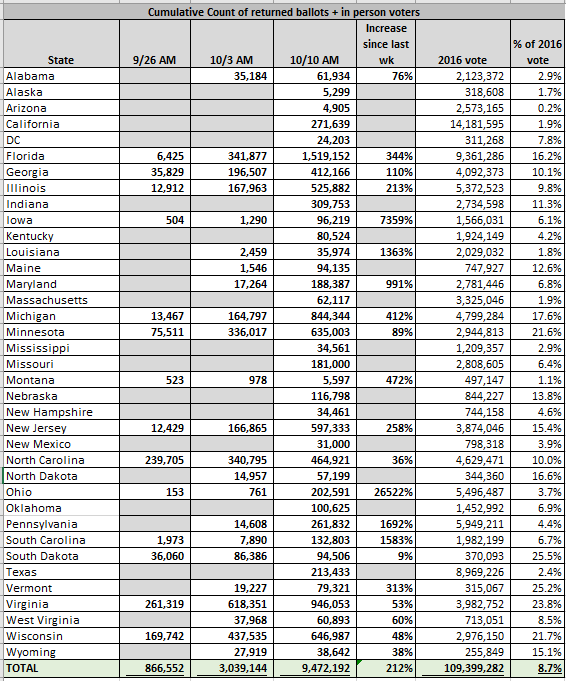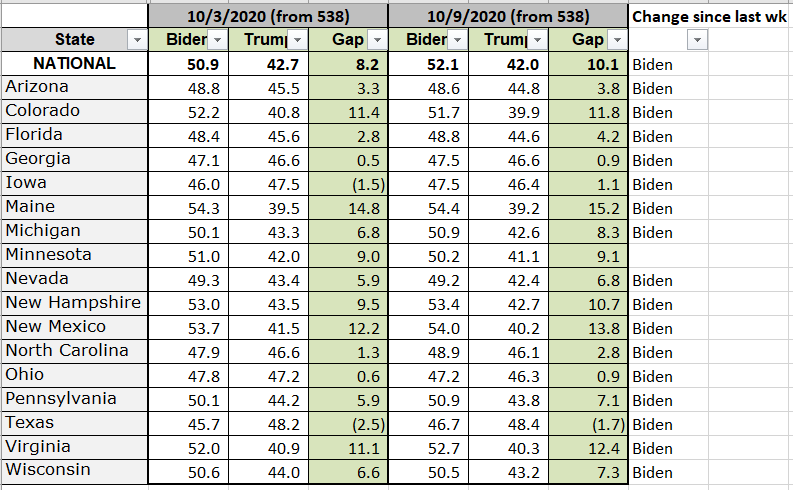With both first Presidential and the Vice-Presidential debates completed and Election Day just over three weeks away (in six days, in person early voting starts in Louisiana), election season continues to move at an accelerated pace. Given that accelerated pace, JMC will in this article discuss the current atmospherics of the election cycle by focusing both on early voting and available polling.
Discussion Point #1: Not “Election DAY”, but “TWO MONTHS of Election DAYS”
The coronavirus pandemic has been a disruptive event in many ways, and one of the consequences of that disruption has been an almost overnight change in people’s preferences regarding how they vote – specifically, a surge in mail in voting. Two local examples best illustrate this sea change: Louisiana and Georgia, as voters on their own initiative decided to vote by mail (as opposed to states like New York and New Jersey, where the change to vote by mail was mandated by the state government). In Georgia, mail ins between 2016 and 2020 increased from 2 to 47% of the total primary electorate, while in Louisiana, what was typically 3% of the electorate surged to 19% in the July primary and 24% in the August runoff.
This change in voting preference has continued into the November election. To illustrate, North Carolina kicked off election season when it sent out mail ballots to those requesting them on September 4. As this article is being written four weeks later, 9,472,192 people have early voted either in person or by mail in 36 states (as well as the District of Columbia) where data is available – a week ago, 3,304,983 in 22 states had. To put that 9.47 million votes in proper historical perspective, at this point in time in 2016, only 410,000 had voted. That number is almost certain to accelerate even more this upcoming week, as (1) in person early voting commences in seven states (including Louisiana); and (2) mail ballots get sent to voters in Colorado, Oregon, Utah, and Washington.
Furthermore, those 9.47 votes/returned ballots are the tip of the iceberg, as 79 million (an increase of 10 million since last week) have requested a mail in ballot, which is a massive number when you consider that nearly 137 million voters participated in the 2016 Presidential election. And even that 79 million number is understated, as it only includes 42 states. Larger states such as New York are not yet included in the totals (as well as other 7 additional states). A detailed breakdown of how voting has progressed is below:

What does this elevated interest in mail in voting mean closer to home ? In Georgia, 207,716 voted by mail in the 2016 General Election; right now, 1,589,147 have requested a mail in ballot (and 412,166 have already voted). Here in Louisiana, 63,016 voted by mail in 2016; this past week, 195,931 have requested a mail in ballot, and 35,974 have already voted (nearly triple the previous week’s number). Keep in mind that all of this is occurring before in person early voting in Louisiana commences on October 16 and continues until October 27.
Discussion Point #2: Polling
National polling (and to a large extent, state polling as well) has been relatively stable thus far in the race. Six weeks ago, Joe Biden had a 50-43% lead over Donald Trump in the national polls. Since then (and in the aftermath of two debates and President Trump’s contracting the coronavirus), Biden has widened his lead to 52-42%, and in 17 of 18 swing states being tracked, he has seen additional improvement in his numbers relative to last week (Trump did not see an improvement in ANY state, and the race was unchanged in Minnesota).

Being behind 10 points in the poll (and not even attaining the 46% of the national popular vote he received in 2016) is now a “code red” for the President. He HAS to close his polling gap by THREE points each week if he wants to attain 270 electoral votes in November. And that’s even considering that people are making up their minds now and voting in far greater numbers at this point in time relative to 2016. Biden has his own challenges as well: with it being uncertain as to how any remaining debates will be conducted, he has to depend on both paid and free media coverage to get his message through.
These poll numbers also have major implications in terms of control of both the US House and US Senate, as those races are also on the ballot, So what does an 10 point poll lead for Biden mean in practical terms? While Barack Obama’s 2008 win was a 7 point victory; a 10 point lead is equivalent to the Reagan landslide win over Jimmy Carter in 1980, which brought massive Republican gains in both houses of Congress (Obama’s 2008 similarly swept many Democrats into Congress that year). Given the increasing prevalence of straight ticket voting, Republicans can’t afford to allow that poll lead to remain. Especially since at this point in time in 2016, the national polling average showed Hillary Clinton with a 45-43% lead over Trump (as compared to the 52-42% lead Biden enjoys now).
